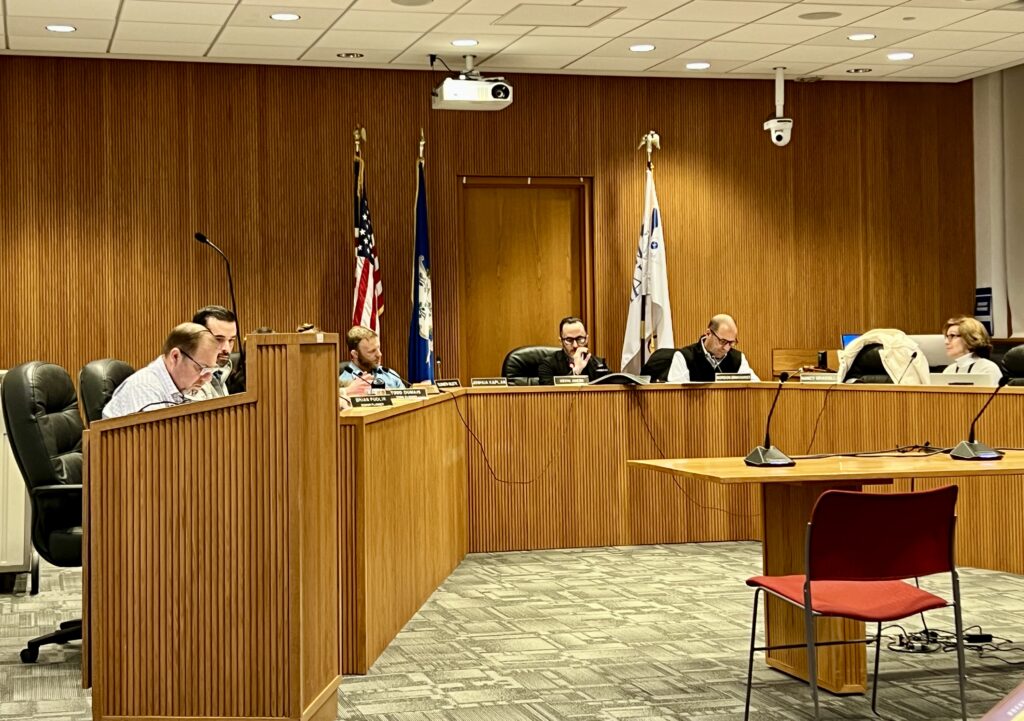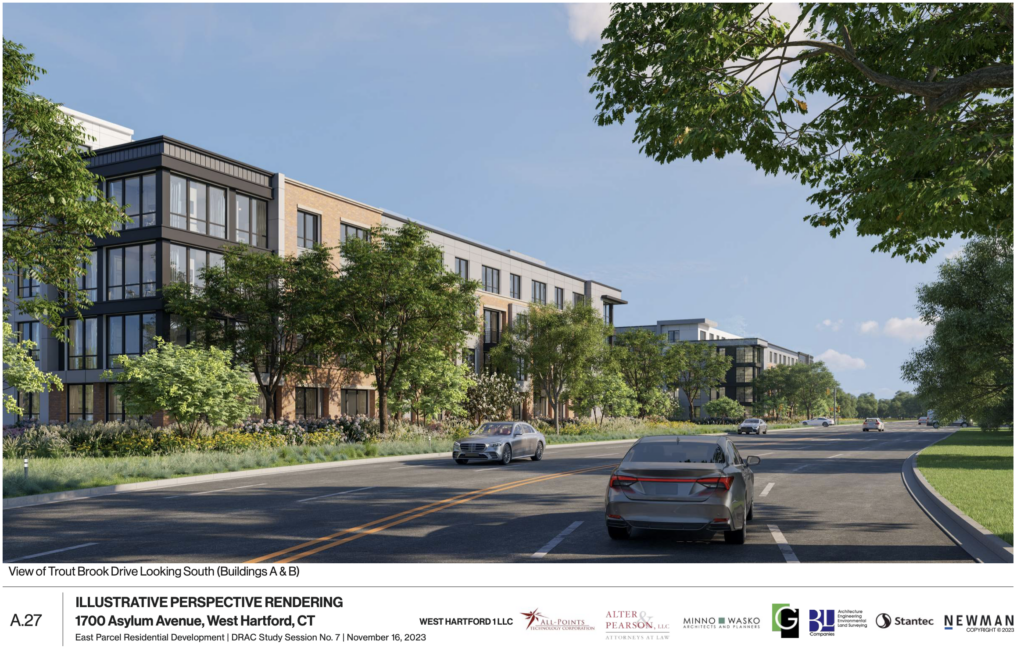Former UConn West Hartford Campus Developer Passes First Hurdle

Audio By Carbonatix

Rendering of a portion of 1700 as proposed by West Hartford 1 LLC to Design Review Advisory Committee on Nov. 16,, 2023. Town of West Hartford website image
West Hartford’s Inland Wetlands and Watercourses Agency approved the wetlands application for 1700 Asylum Avenue on Wednesday night.

West Hartford’s Town Plan & Zoning Commission, in its capacity as the town’s Inland Wetlands and Watercourses Agency, meets on Wednesday, Jan. 17, 2024. Photo credit: Ronni Newton
By Ronni Newton
West Hartford’s Town Plan & Zoning Commission (TPZ), acting in its capacity as the town’s Inland Wetlands and Watercourses Agency (IWWA), convened for a special meeting Wednesday night to take action on a portion of a proposal by West Hartford 1 LLC for development of the former UConn campus that was first submitted last summer.
The wetlands application was approved Wednesday for 1700 Asylum Avenue – the eastern portion of the former UConn campus that is currently an asphalt parking lot with more than 1,000 spaces.
“We are pleased to have received the wetland permit approval for the portion of our proposed project at 1700 Asylum Avenue,” Domenic Carpionato, principal of West Hartford 1, said Wednesday night in a statement shared with We-Ha.com. “With each step in the permitting process, we have worked with the town to improve our plans and minimize impact on the site wetlands, and we look forward to continuing through the permitting for our entire mixed-use village on both parcels at 1700 and 1800 Asylum Avenue.”
Following roughly 15 hours of testimony split into three sessions of a public hearing on the wetlands application for 1700 Asylum Avenue, that TPZ held in its capacity as the Inland Wetlands and Watercourses Agency, the hearing was closed on Dec. 13, with the vote ultimately delayed until Wednesday to allow time for commissioners to complete their review of more than 1,000 pages of testimony.
On Wednesday night – following a reminder by Chairman Kevin Ahern that the agency is “not a mini EPA” and the application needed to be viewed only through a wetlands lens, not considering any other potential environmental impact, and based on the evidence submitted for the record – the agency first considered an Intervener Petition submitted by West Hartford residents Christine Feely, Jessica Rubin, and Gary Schulman.
In considering the Intervener Petition, IWWA needed to “determine if the regulated activities are reasonably likely to have the effect of unreasonably polluting, impairing, or destroying the natural resources of the state,” Ahern said. If they determined that was the case, then IWWA needed to “make a finding as to the existence of a feasible and prudent alternative.”
“I considered their petition … it’s a pretty high bar to unreasonably pollute our environment,” Vice Chair Gordon Binkhorst said, noting the need to make the ruling based on evidence that had been submitted. “In my opinion there was nothing in the record from the intervenor’s presentation or cross examination that meets that burden.”
Commissioner Josh Kaplan said he echoed those comments before the agency voted unanimously, 5-0, to deny the Intervener Petition.

Rendering of a portion of 1700 as proposed by West Hartford 1 LLC to Design Review Advisory Committee on Nov. 16,, 2023. Town of West Hartford website image
The IWWA then moved on to consider the wetlands application, to “determine whether the regulated activities may, based on substantial evidence in the record, have a significant impact on wetlands and watercourses,” Ahern said.
“This was a long and complicated process and application, and I considered many different things in terms of the applicant’s presentation,” Binkhorst said. “In my opinion, I don’t see where a significant impact would occur subject to our regulations.”
Commissioner Nancy Grassilli agreed.
While Commissioner Josh Kaplan said he appreciated the thorough case presented by the applicant, he said he wasn’t sure he could vote to approve it because he thought there was the possibility of a significant impact on the wetlands. “My concern with that is relative to the number of large diameter trees that are being taken down,” he said, trees that are within 100 feet of the upland review area and have significant capacity for water and storage with root systems that extend far beyond the crown of the trees.
He suggested a “modest redesign to increase the wetlands buffers” to allow the preservation of many of the large diameter trees, specifically identifying six trees noted on the removal plan that have diameters of 30 inches or more, and which are likely to be at least 100 years old.
“Certainly this is a large development but I would like to point out that the impervious area is reduced from what is there,” Binkhorst said. He pointed out the applicant’s “proposed treatment of stormwater where there currently is none,” as well as the use of pervious pavement, addition of a small rain garden, buffers, and willingness to move the maintenance shed. He said while the mature trees do absorb more water, over time the replacement trees on the site would grow, “and the other elements of the design supersede that.”
Regarding tree demolition, professional engineer Matthew Bruton of BL Companies, which is part of the development team, said during the hearing process that there are 517 existing trees on the 1700 Asylum property. Of those, according to the latest plans 133 trees will be cut down, but 329 will be added in the upland review area and 422 will be added on the parcel as a whole, bringing the total number of trees to 939 post-development.
Commissioner Liz Gillette asked for confirmation of the status of the property to which the standards regarding the impact on wetlands are being applied. Town Planner Todd Dumais said the starting point is the wetlands resource as it exists today, which is largely a paved parking area.
“This has been very difficult to keep inland wetlands separate from use,” Gillette said. “We usually hear these together as a package and there are obvious reasons not to in this case.” She said she has been waking up in the middle of the night thinking about this application. “I really have tried to find those significant impacts on the wetlands and watercourse, and try as I might they just aren’t there,” she said. The one impact the developer stated they would be causing is to fix the outflow, which is what IWWA requires in response to many other applications they consider.
“Because that stupid parking lot has been there forever and ever, we can’t really look at the wetlands properties that would be there if it hadn’t been paved, but it was. And the state did that without permission,” she said. “I will support this application but it is with a heavy heart because I just think of what else it could have been, like Spice Bush Swamp East,” she said. She said in her opinion the developer has met their obligation, and they have worked with the town on proposed changes.
“This process has taken seven months. Everything the town asked for them to do, and modify, and change it appears that they did that,” Grassilli said. “I don’t see any reason at this point not to support,” said Grassilli, noting that her support is just for the wetlands application.
Before the vote, Ahern said he has been a member of TPZ/IWWA for a while, “and when it comes to wetlands applications I have voted ‘no’ on wetlands when I liked the project and ‘yes’ when I didn’t like the project.” It’s not about the overall project he said, noting that he considered the record, and Kaplan’s comments, but his determination is that “substantial evidence” has not been presented to deny the application.
Conditions were added to the approval of the permit, some of which are standard and others which are specific to this application, Dumais said. Among the conditions are relocation of the maintenance garage, relocation of the southernmost stormwater detention system to avoid potential conflict with the root system of the Champion White Oak, and retention of a professional soil/wetlands scientist to provide oversight.
In addition, a request by Kaplan to urge the applicant to consider preserving the three large, 30-inch diameter trees at the southern end of the parcel was added to the conditions of approval. Kaplan said of the six trees he had earlier identified, “those are the three healthiest by far.”
The wetlands application, with the stated conditions, was approved 5-0.
What’s next?
Approval of a wetlands application was required before TPZ, and the Town Council, can consider any proposal by the developer for rezoning and creation of a Special Development District (SDD) for the former UConn campus. The property is current zoned for single family residential use, but for 1700 Asylum the developer is proposing four residential multifamily buildings of four or five stories with a total of 322 residential units.
An SDD application for 1700 Asylum has not yet been submitted.
The wetlands application for 1800 Asylum Avenue – the western, and larger portion of the 57-plus-acre former UConn campus where several buildings must also be demolished and PCBs and other environmental hazards remediated – was withdrawn in December and will be considered separately.
For 1800 Asylum, the developer is currently proposing 14 buildings, including a 117-assisted living facility, 24 townhomes, and 106 apartments in two mixed-use buildings above retail or restaurants. The plans also include a premier restaurant, a destination spa, and an organic grocery store.
The wetlands application for 1800 Asylum has not yet been re-submitted, and no timeframe has been provided by the developer.
Gary Schulman, one of the intervenors, said while that role has ended and the intervenors are disappointed, concerns about the project will shift once additional applications have been filed.
Christine Feely, another of the intervenors, noted that “traffic is a huge concern” along with general congestion the large project will cause in the area.
Like what you see here? Click here to subscribe to We-Ha’s newsletter so you’ll always be in the know about what’s happening in West Hartford! Click the blue button below to become a supporter of We-Ha.com and our efforts to continue producing quality journalism.




[…] The overall project encompasses two separate parcels of land on either side of Trout Brook Drive, requiring two separate applications to obtain wetlands permits, as well as for zoning. The wetlands application for 1700 Asylum, which had been the subject of roughly 15 hours of public hearing split into three meetings, received unanimous approval from TPZ in their capacity as the town’s Inland Westlands and Watercourses Agen…. […]
[…] Jessica Rubin, who was one of three people who filed an Intervener Petition during the Town Plan and Zoning Commission’s review of the wetlands application in their capacity as the Inla…, also expressed her disdain for the […]
[…] Jessica Rubin, who was one of three people who filed an Intervener Petition during the Town Plan and Zoning Commission’s review of the wetlands application in their capacity as the Inla…, also expressed her disdain for the […]
[…] The securing of a wetlands permit by the developer, which was a necessary first step before any official discussion of the change in zoning required to built apartments, was the subject of roughly 15 hours of public hearing split into three meetings, and received unanimous approval from the Town Plan and Zoning Commission (TPZ) in their capacity as the town’s …. […]